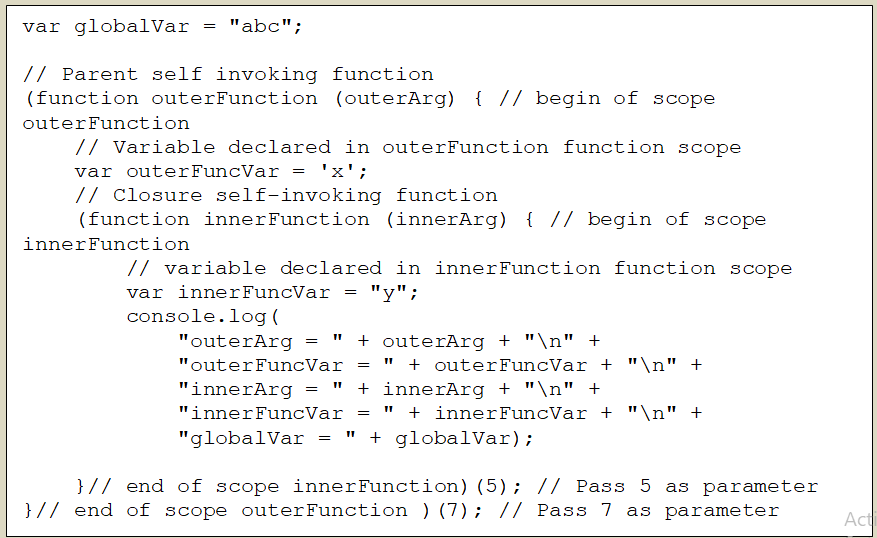Updated May 11, 2023

JS Interview Questions And Answers
Now, if you are looking for a job related to JS, you must prepare for the 2023 JS Interview Questions. Every interview is different as per the various job profiles, but still, to clear the interview, you need to have a good and precise knowledge of JS. Here, we have prepared the critical JS Interview Questions and Answers, which will help you get success in your interview.
Below are the 12 crucial 2023 JS Interview Questions and Answers frequently asked in an interview.
Part 1 – JS Interview Questions (Basic)
This first part covers basic JS Interview Questions and Answers.
Q1. What is JS?
Answer:
JavaScript is a scripting language primarily designed for creating web pages and adding interactivity to web applications.
Q2. How does JavaScript work?
Answer:
These are the common JS Interview Questions asked in an interview. Every browser has three prime components to work. The first one is the DOM (Document Object Model) interpreter. This will take your HTML document and convert it, and displays it in the browser. The other small program part of the browser is a CSS interpreter, which will style the page and make it look better. The last one is a mini-program in the browser called the JS engine.
- The browser loads the HTML file/JS file
- JavaScript is an interpreted language(which means no compilation is required)
- Browser(JavaScript engine) executes line by line and waits for events(like clicks, mouseovers, etc.) to happen.
Q3. Mention some of the features of JavaScript.
Answer:
Below are the different features of JavaScript:
- JS is a lightweight programming language with interpreted functionality
- JS is open-source and cross-platform
- JS is integrated into HTML and Java
- Designed to create network-centric applications
Q4. Regarding JS, what are the different types of JavaScript data?
Answer:
- Strings
- Functions
- Boolean
- Object
- Number
- Undefined
Let us move to the following JS Interview Questions And Answer.
Q5. Define the common errors which occur in JavaScript.
Answer:
In general, there are 3 types of errors we find in JS, which are as follows.
- Runtime error: this is the outcome of the misuse of the commands within the HTML language
- Load tie error: this is a syntax error and is generated dynamically
- Logical fallacy: this error occurs when the logic of the functions is poorly performed.
Q6. Explain why JS is a Case-Sensitive Language.
Answer:
JS is a case-sensitive programming language. In JS, we use different variables, functions, and other identities that should be consistent throughout.
Part 2 –JS Interview Questions (Advanced)
Let us now have a look at the advanced JS Interview Questions.
Q7. List down some of the Advantages and disadvantages of JavaScript.
Answer:
Advantages:
- Rich user interface
- Increased interactivity(when a mouse hovers on elements like buttons or keyboard accessibility)
Disadvantages:
- Lacks multithreading activities
- Not suitable for networking applications
- Client-side JavaScript cannot be read or written.
Q8. Types of objects in JS and define them?
Answer:
There are 2 types of objects in JS:
- Date Object: This is built within the JS programming. These are created using new data and can be operated with the help of an available bunch of methods once created. This includes the date object’s year, month, day, hour, minutes, seconds, and even milliseconds. These are set with the help of local standards of the universal time.
- Number Object: these include the dates solely represented by integers and fractions. The literals of the numbers get converted to the number class automatically.
Let us move to the following JS Interview Questions And Answer.
Q9. What is Closure in JavaScript?
Answer:
When we define a function within another function (a.k.a. parent function) and access the variables described in the parent functions. The closure accesses the variables in three scopes:
- Variables declared in their scope
- Variables declared in a parent function scope
- Variables declared in the global namespace
Code:
innerFunction is a closure that is defined inside outerFunction and has access to all variables declared and defined in the outer function scope. In addition, the function defined inside another function as closure will have access to variables declared in the global namespace.
Output:
Q10. How to empty the array in JavaScript?
Answer:
By following any of the given methods:
- arrayList = [ ]
Above code will set the variable ArrayList for a new empty array.
- length =0;
The above code, first of all, clears the existing array by setting its length to 0. This way is useful when you want to update all the other reference variables pointing to ArrayList.
- splice(0, ArrayList.length);
This way of emptying the array will also update all the references of the original array.
- while(ArrayList.length){
arrayList.pop();
This is one of the ways to empty the array
Q11. Mention some of the JavaScript datatypes.
Answer:
These datatypes generally hold the value. In JS there are two types of data types.
- Primitive datatypes
- Non-primitive datatypes
Under the primitive data types, there are String, Number, Boolean, Undefined, Null, whereas under the Non-primitive, there are Object, Array, and RegExp.
Q12. What do you mean by functions in JavaScript?
Answer:
Functions are a block of reusable codes. This allows a user to write a particular code and use it as many times as per the need by calling the function. A JS function is not necessary to return a value. There are 2 types of functions JS support.
- Anonymous functions
- Named functions
The syntax for JS function –
Function functionName (parameter1, parameter2, …..parameter n)
{//statement of the functions
}We must use the process followed by the function name and parenthesis to declare a function. Within the parenthesis, we must specify the function parameters (they can have multiple parameters).
To call the function, we have to specify the procedure’s name and, within parenthesis, the values of the parameters (pass the values).
Add numbers (x1, x2) – here, we have given the values and called the functions.
Note: If there are 3(let’s say) parameters in the code and we pass 3 or more parameter values. In this case, JS will ignore the additional parameter values.
Recommended Articles
We hope that this EDUCBA information on “JS interview questions” was beneficial to you. You can view EDUCBA’s recommended articles for more information.



